Duomo of Barcellona Pozzo di Gotto
The Cathedral of Barcellona Pozzo di Gotto or Duomo of Saint Sebastian or Duomo of Barcellona Pozzo di Gotto, exact full name Minor Basilica of Saint Sebastian, is a basilica cathedral in Barcellona Pozzo di Gotto, Sicily, Italy.
It stands in the Piazza Duomo with its main façade facing the Via Roma. It is the largest of the churches of Barcellona and second only in size to the Cathedral of Santa Maria Assunta at Messina in the province of Sicily. The engineer Barbaro, nephew of Monsignor Barbaro, directed the work, which was carried out by the firm Fratelli Cardillo, having collaborated in the construction of the Shrine of Christ the King, a work contemporary with that of the Cathedral of Saint Sebastian.
Note on the cult of St. Sebastian
The cult of Saint Sebastian in many centers of Sicily dates back to 1300, when the martyr of Narbonne, originally from Milan and who was considered the protector against epidemics of bubonic plague, encouraged the construction of many churches. The cult took root in the village of "Barsalona" on the west side of the river Longano and fraction of Castroreale around 1500, replacing the then patron St. Nicholas of Bari. St. Sebastian's miraculous survival despite the many perforating arrows was transposed onto a figure who became the holy intercessor against outbreaks of disease. The Black Death (in the north Italy, better known as plague of St. Charles Borromeo) assailed the island in 1347, 1449, 1524, and 1575 – 1578.
The Basilica
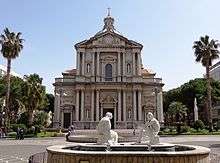
Following the administrative merger of Barcellona and Pozzo di Gotto in 1836, the doubling of the population required a new larger temple. The project was accelerated by the disastrous 1908 Messina earthquake that damaged the old Cathedral of St. Sebastian and made it unusable. The old cathedral, dating from 1606, would have also prevented the construction of the Via Roma, the natural access to the railway station. It formed, together with the adjacent Church of Agonizing, the Placido Mandanici Theatre (destroyed by fire in 1967) and the Monte di Pieta, the old city of Barcellona until the first decades of the 1900, when it was completely demolished during the building of the new Cathedral.
After the adoption of the plan on April 1, 1931, construction started on January 25, 1932 and ended October 30, 1935. The cathedral was inaugurated on March 25, 1936 by the Archbishop of Messina, Monsignor Angelo Paino. The laying out of the square in front ended with the elevation of the Cathedral to the status of Minor Basilica by Cardinal Angelo Sodano on September 18, 1992.
Facade
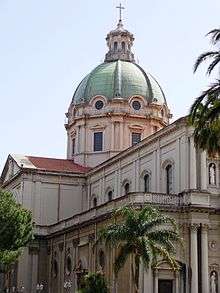
The Basilica facade is reminiscent of that of Basilica of Sant'Andrea della Valle in Rome. The dome drew inspiration from that of Filippo Juvarra for the Basilica of Superga in Turin. The twin ribs of Juvarra's Turin dome, simplified and lightened, also appear in the dome of the Shrine of Christ the King. Likewise, the dome for the new Cathedral of Barcellona was similar to that of the New Cathedral of Brescia in shape, size and style, although the latter lacked the small circular windows round the base.
In the Barcellona church, the terraces covering the side aisles are much wider, allowing the construction of two small front entrances. The facade is a modern representation of the neo-classical style with two rows of columns surmounted by Corinthian capitals framing the main window, the main entrance and the side niches. The eight central columns is slightly advanced with respect to side group, the four central columns further advanced, enclosing an embossed tympanum of a lively and dynamic character. Within the gable of the tympanum is a frieze decorated with carved elements of cardinal symbols and festoons bearing a palm tree between two lions. The coat of arms and motto "SOLUS CUM SOLO DEO" can be traced back to the order of Saint Paul.
Entrances and windows are framed by columns surmounted by arched triangular typani. The niches are surmounted by triangular arched pediments. The niches of the main façade are enriched by four statues of Saint Peter, St. Paul, St. Francis of Assisi and St. Catherine of Siena by Domenico Farina, which create a delicate contrast between the bright white of the marble statues and the stonework from the quarries of Billiemi and Comiso.
On the inner wall of the entrance from top to bottom and from right to left are "The Creation","The Expulsion from Eden" or " Original Sin", "God and the Tables of the Commandments" and "The Baptism in the Jordan", frescoes created by Gino Colapietro in 1997.
Main nave
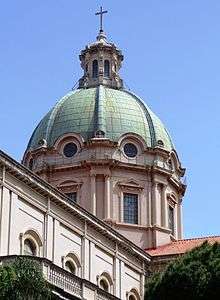
The basilica is in the form of a Latin cross with a large central nave with a barrel vault adorned with friezes, rosettes and stucco.
The interior space is divided into three naves by means of strong pillars carrying large arches embellished by twin pilasters. The central nave is about 25 meters long from the inner entrance to the transept, 16 meters wide and 23 meters high, and both visually and acoustically constitutes the main architectural feature of the building. Within the five arches of each side aisle are arranged six altars and two side entrances.
Right aisle, south side
- In the first bay to the right is the marble inscription reproducing the text of the Papal Bull of Pope John Paul II decreeing the elevation to Basilica status of 9 November 1989. The elevation took place on 9 February 1991, with a dedication ceremony on 18 September 1992.
- Second bay: Altar dedicated to Virgin of agonizing from the Church of Agonizing (end of the 16th or early 17th century). An altarpiece by Philip Jannelli (1621 c. – 1696) painted in oil on canvas of the Virgin of Agonizingin which the Virgin is depicted between St. Michael the Archangel, St. Camillus de Lellis and St. Joseph 1655 (?). The elevation of the altar consists of pilasters surmounted by a symmetrical arched pediment. At the centre is a refined tabernacle depicting a Roman temple colonnade surmounted by a crown.
- Third bay: Entrance from the south side.
- Fourth bay: Altar dedicated to the Patriarch St. Joseph brought from the Old Cathedral (end of the 16th or early 17th century). The altarpiece is a 1942 painting of St. Joseph by Santa Rugolo. The elevation is pilasters surmounted by a symmetrical arched pediment with central stele. Tne altar table has a precious marble frontal.
- Fifth bay: Altar dedicated to Our Lady of Graces, patron saint of the city from the Old Cathedral. Pilasters surmounted by symmetrical arched pediment with central stele.
Left aisle, north side
- In the first bay on the left was originally placed the baptismal font now transferred to the altar. On the walls the memorial plaque stating the naming date of March 25, 1936 and the dedication date of June 8, 1986. A commemorative plaque attesting the construction of the cathedral to the Archbishop of Messina, Monsignor Angelo Paino.
- Second bay: Altar dedicated to St. Anthony of Padua, made in 1940. Pilasters surmounted by symmetrical pediment with central stele. In the niche is a statue of St Anthony.
- Third bay: Entrance from the north side.
- Fourth bay: Altar dedicated to Triumph of the Cross between Jesus and Mary from the Old Cathedral. The altarpiece by Philip Jannelli (1621 c. – 1696) is "Jesus and Mary and the Triumph of the Cross", painted in oil on canvas. Pilasters surmounted by symmetrical arched pediment with central stele. A precious marble altar frontal.
- Fifth bay: Altar dedicated to Sacred Heart of Jesus from the Old Cathedral. It has a double pair of columns, the innermost advanced and surmounted by a symmetrical pediment.
Transept
In the south transept is a modern, linear and sumptuous marble altar in the classical style by Antonino Antonuccio, consisting of pillars (pilasters) combined with Corinthian capitals and surmounted by symmetrical pediment connected with two volute down crowning a disc surmounted by a vase. At the extremes of the dynamic entablature are two other vases, in the niche framed by pilasters and arched tympanum is preserved an 18th-century wooden statue of St. Sebastian which is carried in procession. Overlooking the choir is a 17th-century painting depicting scenes from the life of St. Christopher. In the fresco depicting the Miraculous shoal of fish by Gino Colapietro (1994) on the north wall of the transept, the features of the characters recall the faces of citizens amongst which the principal face of the archpriest stands out. Below are three austere but valuable denominational works of the local cabinetmaker Antonio Genovese based on drawings by Salvatore Crinò dating back to the '60s. In a square frame is a painting of the Virgin and Child with Saint Francis of Gaspare Camarda (1606).
There are also four mosaics depicting The Annunciation, The Nativity, The Adoration of the Magi and The Presentation of Jesus in the Temple Claudio Traversi. On the external wall are reproduced the figures of St. Nicholas of Bari and San Francesco di Paola behind the bronze statue of St. Pio of Pietrelcina, 2001 .
| --------------- North transept ------------------- | ---------------- South transept ------------------- |
|---|---|
| The Nativity | The Annunciation |
| Saint Nicholas of Bari (External) | Saint Francesco of Paola (External) |
| The Adoration of the Magi | The Presentation of Jesus in the Temple |
Altar
The main altar is made of polychrome marble, whose elevation depicts the elevation of a Roman temple with a symmetrical double interrupted pediment with central memorial stele. The whole recalls the style of the facade. Between the columns with their Corinthian capitals is a canvas depicting the Martyrdom of St. Sebastian where Irene of Rome in mourning retrieves the body of the saint, and a maid and St. Nicholas of Bari (former protector of the village of Barsalona) are kneeling, the work of Giacomo Conti in 1879. Completing the scene the Madonna in Glory, with Our Lady of Graces the co-Patron saint of Barcellona Pozzo di Gotto, is pictured between hosts of angels, cherubim and seraphim, thrones and dominations. The marblework was undertaken by Salvatore Manganaro, directed by Maria Mento and Angela Mento and completed in 1960.
The Christ Pantocrator in the apse is the work of Filippo Minolfi and was created in 1984. The Cathedral contains many paintings of the 17th and 18th centuries, on the left side of the altar stands the painting of the 19th century depicting the Madonna of Carmel and Saints, (Saint Roch, St. Paulinus of Nola and Saint Catherine of Alexandria) by Cesare De Napoli.
Doors
The anterior approach to the basilica is secured by three doors, at one time made of wood but now of bronze.
The great bronze door of the nave by Ennio Tesei has panels depicting scenes from the life of Saint Sebastian. The six panels depict: The first martyrdom with arrows, The second martyrdom with flogging to death (the palms of martyrdom are the handles of the two doors), The care of St. Irene, the Sermons of St. Sebastian, the meeting with the Emperor Diocletian,the Cloaca Maxima, performed 1990. The door is topped with a fluted frieze bearing the symbols of martyrdom: the arrows and a crown and palm.
The right door, the work of George Luzzietti, has panels depicting Pentecost,Ascension,The Multiplication of the Loaves and Fishes,The Miraculous, The Marriage at Cana and The Resurrection of Lazarus.
The left door, the work of Claudio Traversi in 1991, has panels depicting scenes from the Flood,The Tables of the Law and the Burning Bush,The Church of the Basilian,The old Cathedral of St. Sebastian, the New Basilica and a panel dedicated to Monsignor Angelo Paino, called The Rebuilder.
Dome
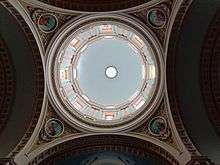
The dome, emblem of the basilica and one of the symbols of the entire city is 16 meters in diameter and 8 m in height, surmounted by an octagonal lantern. It is illuminated by eight windows arranged around the drum and eight oculi arranged around the cap.
It rests on a high octagonal drum with eight rectangular windows, separated by ribs defined on the outside by pairs of coupled columns. At the base of each rib are shells containing doves.
Internally the four pendentives at the base of the drum are decorated by the four Evangelists, created in 1986 by Filippo Minolfi. The eight rectangular windows on the drum of the dome were made in the early 1990s by Salvatore Gervasi .
Further detail
The Basilica of Saint Sebastian is the second largest Catholic church in the province of Messina.
Several events have led to modifications, especially the elevation to Basilica status. Disappearance of the original front staircase, balustrade and railing that separated the transept from the high altar, the "table" under the dome replaced by the table altar "coram populo", the rearrangement of some of the works on display and the paintings that encircle the altar, replacement of the old windows with stained glass. In 2000, the new Chapel of the Confessions, the Chapel of the Holy Sacrament, was constructed and the rooms of the parish offices and corridors completely rearranged. The sacristy was fully restored with a new marble floor and new cabinets, the layout of the presbytery changed with a new pulpit, the baptismal font and the organ console moved and the wooden stage for the choir in the right transept built.
- Windows in the apse: "Sacred Heart" on the right side of the apse, by the brothers Lindo Grassi and Alessandro Grassi year 1970 and "Immaculate Heart of Mary" on the left side of the apse, the work of Cupelloni year 1992.
- "Saint Sebastian" on the window of the main façade loggia, by brothers Grassi.
- Windows in the nave: "Resurrection", "The Crucifixion", "St. Thomas the Apostle and St. Jude", "St. Dominic and St. Francis of Assisi", "Saint Eustochia Smeralda Calafato and Saint Clare of Assisi","St. Andrew and St. Philip","St. James, son of Zebedee and St. Bartholomew", "Saint Peter and St. Paul","St. Simon and St. Matthew","St. John the Evangelist and St. Matthias","St. Nicholas and St. Basil","Saint Agatha and Saint Lucia", works of the Father Alberto Farina year 1991.
- Windows round chapels: "Sacred Heart of Jesus", "Lady of Fatima", "Saint Joseph", "Souls in Purgatory", "Triumph of the Cross", "St. Anthony of Padua", "The Holy Spirit", " St. Christopher", works of Claudio Traversi year 1992.
- Windows in the drum of the Dome: Eight rectangular windows in the drum of the dome by Salvatore Gervasi.
Choir
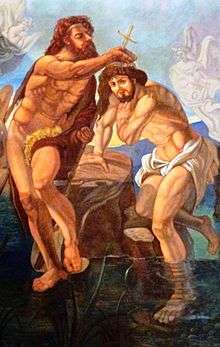
The choir is composed of wooden seats in a classical style, made in September 1985 by Sanyi Diletti, designed by Angela and Maria Mento.
Organ
The organ of the basilica was built by Tamburini of Crema, Lombardy in 1967. The organ is in two parts, located in the transepts of the choir of the Basilica, the Cornu Epistulae and Cornu Evangelii, and consists of 2,760 pipes, a console with three keyboards, 61 keys, 32 pedals and 41 real sound registers. After the instrument of the Cathedral of Messina, it was at the time of installation the second largest organ in the entire province.
Bells
In 1989 nine new bells from Catania foundry, the largest of which are 109 cm in diameter and perfectly matched in gradual decreasing tone replaced the bells from the old cathedral. Finally a carillon clock complete with four quadrants of 169 cm in diameter each was installed.
Sacristy
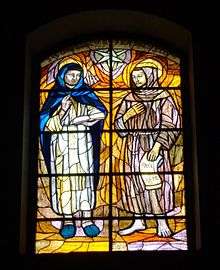
In the sacristy, located behind the apse and communicating with the ambulatory and transept on both sides are kept: the sarcophagus of the philanthropist Giovanni Spagnolo (1791), a marble statue of the Madonna of the Rest (end of the 16th or early 17th century); ten canvases in a frame with scenes from the life of Saint Sebastian (a relic of the 18th century) and an organ casing with wooden carvings from the early 18th century.
Archpriest
Archpriest is the dean over the priests of a parish, responsible for the proper performance of ecclesiastical duties and to the lifestyle of the priests submitted to it.
- Archpriest Nunziato Bonsignore to guide of the Arcipretura from 1914 to 1941.
- Monsignor Domenico D' Arro.
- Monsignor Salvatore Stracquadaini.
- Monsignor Francesco Mento (1911–2007) to guide of the Basilica from 1958 to 2001.
- Father Francesco Farsaci.
Trivia
- Until the early 1900s during the processions of 20 January it was the custom to throw chickpeas against the statue of the saint as a devotional act of liberation from sin, a custom no longer allowed by the ecclesiastical authorities. Another anthropological aspect inherent to the act is the form of thanksgiving for having fed the prisoners and the poor in Rome and for the work of evangelization carried out at the cost of supreme sacrifice.
- The Ciaurrina is a stretched candy bar typical of Barcellona, made during the festival of Saint Sebastian, where the initial pressing of the honeydough is reminiscent of the tension of the bow and the firing of the arrows.
- The phrase U brazzu di San Bastianu. In the cathedral is a priceless relic that is the bone of the forearm of the holy martyr called the Brazzu of San Bastianu, often quoted in local sayings such as ... the intervention of the Brazzu of San Bastianu is needed!, invoked at a time when an important and decisive aid would be favouravble.
Gallery
 Fresco, North wall of Minor Basilica of St Sebastian.
Fresco, North wall of Minor Basilica of St Sebastian.
See also
- History of Roman Catholicism in Italy